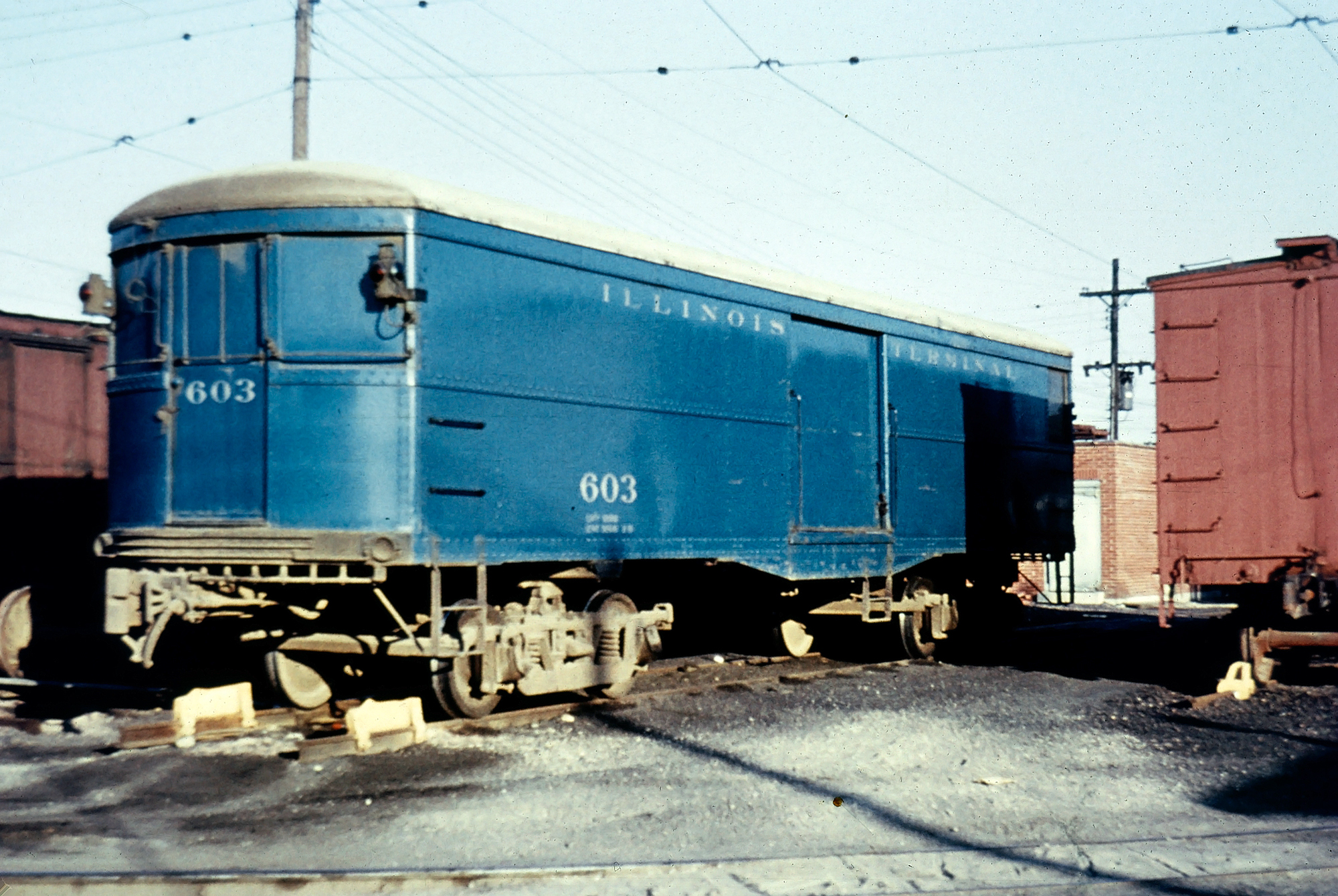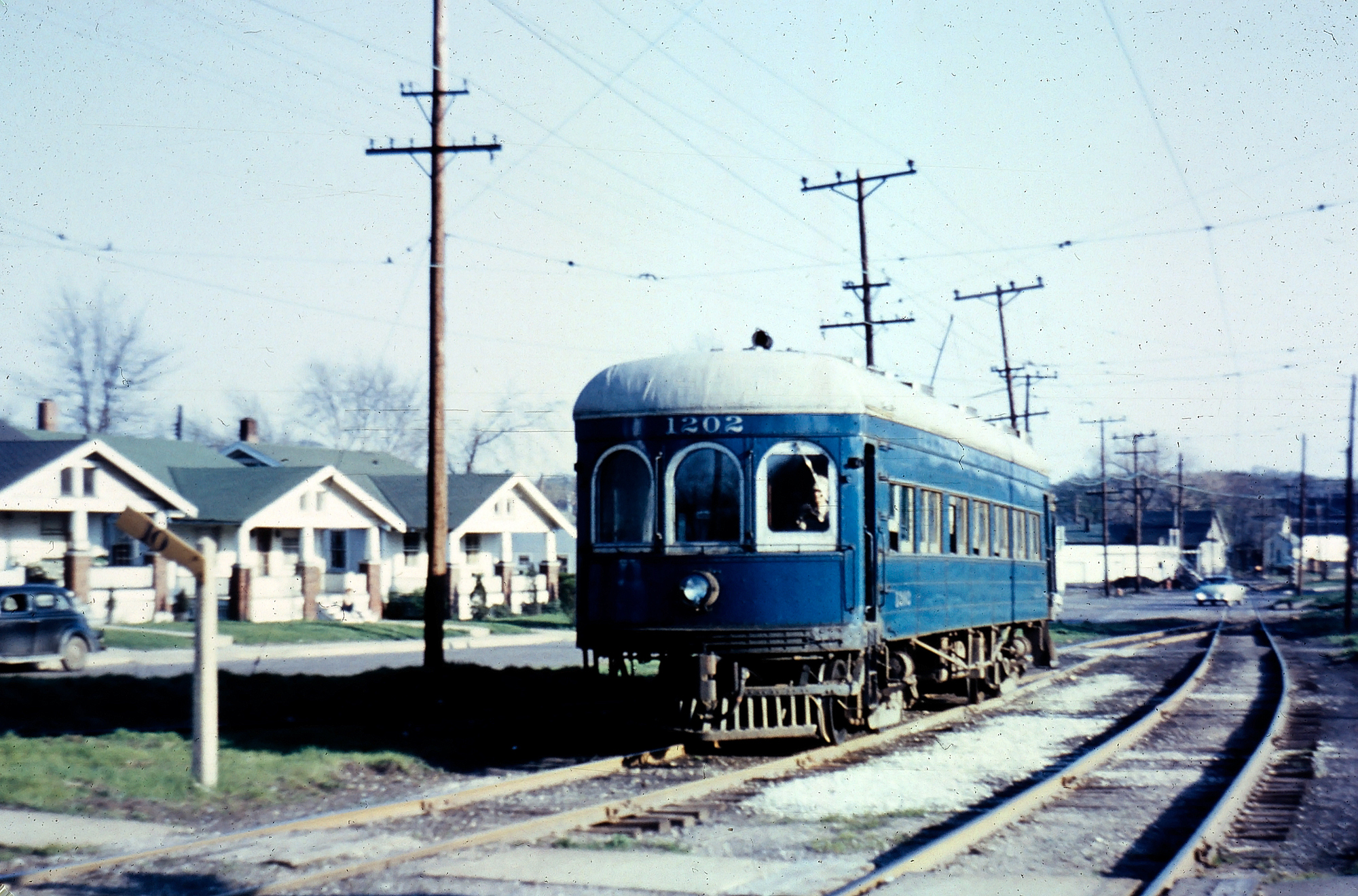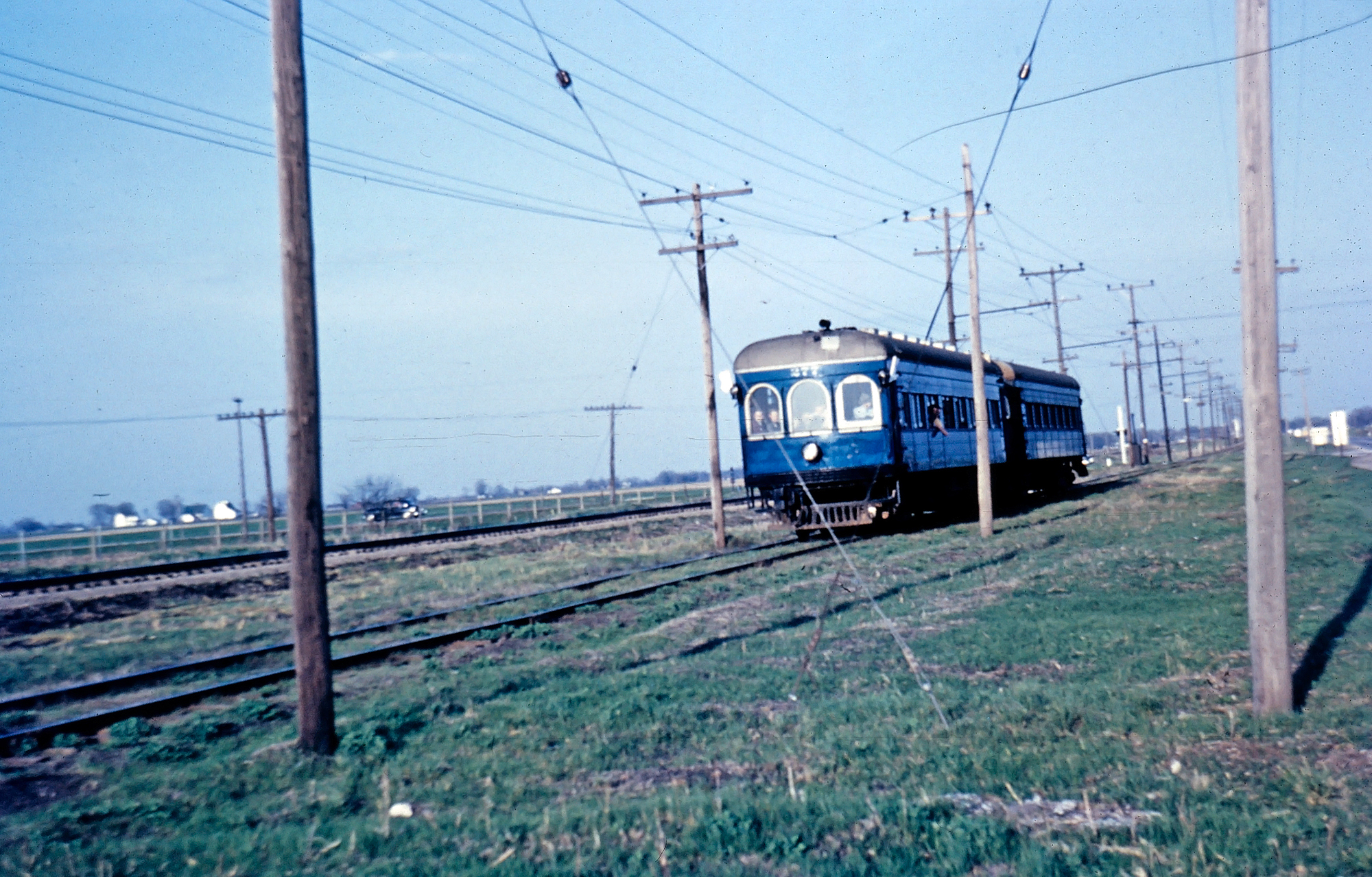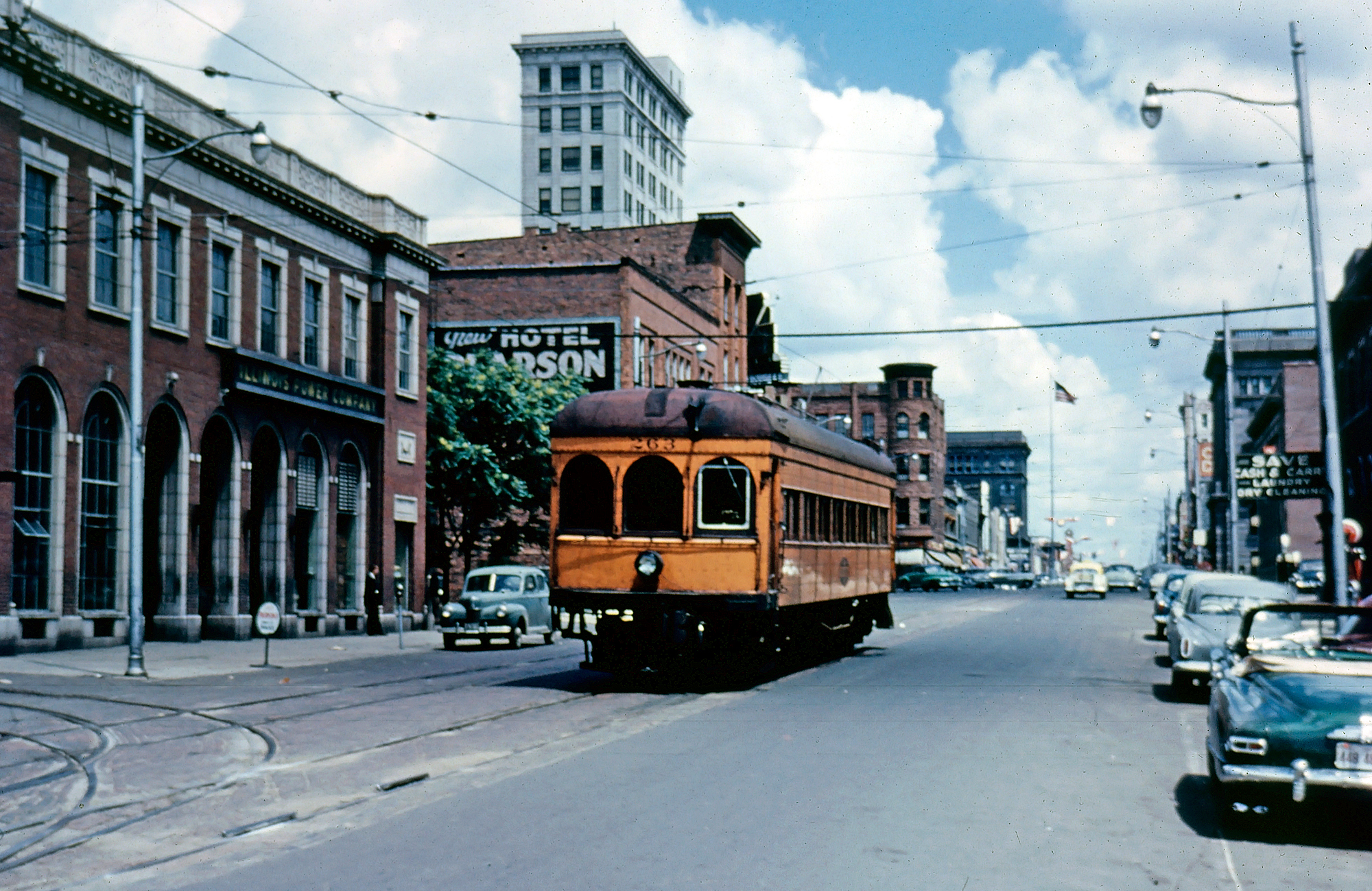- Home ›
- Interurbans ›
- Illinois
Illinois Interurbans and Streetcars: History, Lines, Photos
Last revised: September 10, 2024
By: Adam Burns
At its peak, Illinois contained 1,422 miles of interurban trackage, ranking it fourth in the United States. It boasted the largest, and most successful end-to-end system in the Illinois Traction system, which later became the Illinois Temrinal.
In 1950, the IT operated 462 route miles, linking St. Louis with central Illinois. Most of the state's interurbans were concentrated around either St. Louis or Chicago although several, small disconnected systems could be found scattered throughout the state.
Most of these operations were gone by the 1930s. However, the Chicago, Aurora & Elgin and Chicago, North Shore & Milwaukee ("North Shore Line") survived until the early 1960s while the Illinois Terminal carried on as a general freight line until its 1982 merger with Norfolk & Western. Finally, the Chicago, South Shore & South Bend continues to operate today as an important rapid transit system for the northwestern Indiana and Chicago regions.
 Illinois Terminal express car #603 is seen here stored at the station in East Peoria, Illinois, circa 1950. James Stitzel photo. American-Rails.com collection.
Illinois Terminal express car #603 is seen here stored at the station in East Peoria, Illinois, circa 1950. James Stitzel photo. American-Rails.com collection.Chicago, North Shore & Milwaukee Railway
The CNS&M, commonly known as the "North Shore Line" had a history that began in 1895 as the Bluff City Electric Interurban Street Railway, originally serving Waukegan with North Chicago's 10th Street.
It continued to grow and before 1900 reached 22nd Street and Highland Park, causing it to be reorganized as the Chicago & Milwaukee Electric Railroad in 1898 as expansions continued.
The company continued to grow through the 1900s reaching Evanston, Lake Bluff, Libertyville, Mundelein, and Racine by 1906.
A year later the company directly served Milwaukee although the financial panic that year forced it to wait another year before implementing services.
Unfortunately, the panic eventually brought bankruptcy where it was purchased by the Insull interests in 1916, which renamed it as the Chicago, North Shore & Milwaukee.
Under new ownership it was finally able to reach downtown Chicago in August, 1919 through trackage rights via the Milwaukee Road and Chicago Elevated (the "L").
It continued to improve operations through the 1920s and remained relatively profitable prior to the Great Depression, a time when many interurbans were disappearing.
The depression resulted in reorganization as Insull went under, which occurred in 1946. Because the North Shore Line never had extensive freight operations and was not truly equipped to handle the heavy rush hour traffic, along with declining passenger traffic after World War II it slowly crumbled.
After legal fights it was finally abandoned on January 21, 1963. The North Shore is notable for two things; offering very high speed service and was the first true railroad to utilize piggyback freight service in the 1920s (yes, even before the Chicago Great Western!).
Chicago, Aurora & Elgin Railway
For more information on the CA&E please click here.
Chicago & Southern Traction Company
The C&ST began operations on October 5, 1907 serving Kankakee with 79th and Halsteed Streets, Chicago, a distance of nearly 54 miles.
Its history dated as far back as 1897 and it was not electrified until 1901. Bankruptcy in 1911 resulted in reorganization as the Chicago & Interurban Traction, which is covered in more detail below.
Aurora, Elgin & Fox River Electric Company
This system served the Fox River Valley in Illinois had dated back to the 1890s as one of the earliest interurbans in the country. By 1901 it was serving Elgin, Carptersville, Geneva, Batavia, and Yorkville.
It was soon acquired by the Pomeroy-Mandelbaum syndicate, which owned the CA&E and renamed that year as the Elgin, Aurora & Southern. After bankruptcy in 1919 it was sold by the CA&E and renamed as the Aurora, Elgin & Fox River. Another casualty of the Great Depression it was eventually abandoned on March 31, 1935.
Chicago, South Shore & South Bend Railroad
For more information on the Shore Shore Line please click here.
Alton, Granite & St. Louis Traction Company
The Alton, Granite & St. Louis Traction Company was a creation in 1904 of several smaller interurban systems serving Alton.
By 1920 the system was in financial trouble and was taken over by the Alton Railway in 1926. On July 1, 1930, the Illinois Power & Light Corporation purchased the property and finally the Illinois Terminal Railroad took over the system as year later on March 1st.
The system continued to flounder and was finally completely replaced by buses in the summer of 1936.
Alton, Jacksonville, & Peoria Railway
The Alton, Jacksonville, & Peoria Railway was a failed venture meant to connect Alton and Peoria. It was able to connect Alton and Godfrey, a distance of 5 miles as well as a branch to Jerseyville but quickly found itself in financial trouble. By 1918 the railroad had been abandoned.
Northern Illinois Electric Railway
The Northern Illinois Electric Railway began operations in 1910 connecting Amboy and Lee Center, a distance of 11 1/2 miles.
The NIER was another failed interurban connecting two sparsely populated towns. It was sold to the Lee County Central Railroad in the summer of 1914 and passenger operations were terminated in the early 1920s.
Interestingly, part of the line remained in service until the 1960s, used by the Chicago, Burlington & Quincy Railroad to serve nearby grain elevators.
Elgin, Aurora & Southern Traction Company
The Elgin, Aurora & Southern Traction Company began operations in December 1903 serving Aurora, Batavia, Geneva, St. Charles and Elgin. It was merged into the Chicago, Aurora & Elgin Railroad in 1905.
St. Louis & Belleville Electric Railway
The St. Louis & Belleville Electric Railway was a subsidiary of interurban East St. Louis & Suburban Railway and predominantly provided freight service.
After the EStL&S was abandoned in 1928 the StL&BE was acquired by the Union Electric Company it was renamed the Peabody Short Line Railroad and continued to haul coal, its primary source of traffic for most its existence.
It eventually was purchased by the Illinois Central but since the line duplicated a nearby IC line it was abandoned in the early 1960s.
Elgin & Belvidere Electric Railway
The Elgin & Belvidere Electric Railway connected Belvidere and Elgin on a line that stretched about 36 miles.
It opened for operation in 1907 and became a central link for the Chicago, Aurora & Elgin between Freeport, Rockford, Elgin and Chicago. It remained in operation until 1930 when it was abandoned.
Bloomington & Normal Railway
The Bloomington & Normal Railway dates back to 1867 serving its namesake cities. It switched from horse to electric streetcars in 1890. The B&N at its peak operated eight different lines. The railroad lasted until December of 1936 when it was abandoned.
Bloomington, Pontiac & Joliet Electric Railway
The BP&J had grand schemes of connecting Chicago and St. Louis but only ever connected Pontiac and Odell, an distance of 10 miles opening on March 15, 1905.
It was also able to build an 8-mile branch to Dwight a year later. Serving only small communities profits were limited. As such, abandonment occurred on November 24, 1925.
Cairo Electric & Traction Company
The Cairo Electric & Traction Company was known by several different names including the Cairo Street Railway and Cairo Railway & Light System. It served Cairo and was taken over by the Illinois Power & Light Corporation in 1923. The railroad was abandoned for buses in 1931.
Calumet Electric Street Railway
The Calumet Electric Street Railway served southern Chicago beginning operations in 1890. It lasted for only 18 years when it became part of the South Chicago City Railway Company in 1908.
Illinois Central Electric Railway
The Illinois Central Electric Railway was chartered in October of 1903. It began operations on June 3, 1907 connecting Canton with St. David. Eventually the system was able to reach Norris, Fairview, Gilchrist and finally terminating in Farmington by 1912.
Later that year the interurban also completed a branch from St. David to Lewistown. The interurban remained in operation until September 13, 1928 when services were discontinued.
Illinois Power Company
The Illinois Power Company was founded by William McKinley in 1890 to serve the city of Champaign and Urbana. At its peak it operated 20 routes. It was sold to National City Lines in October of 1935 and remained in operation until November 10, 1936 when the system was discontinued in favor of buses.
Chicago & Interurban Traction
The Chicago & Interurban Traction was created in February of 1912 to take over several defunct interurbans.
The first of these was the Engelwood & Chicago Street Railway incorporated in 1893 to serve southwestern Chicago. It went bankrupt in 1896 at which point the newly created Chicago Electric Traction Company took over a year later.
This company too went bankrupt and the Chicago & Southern Traction Company was created to take over operations. After the C&ST also entered receivership the Chicago & Interurban Traction took over operations in 1910.
At this point the system connected 63rd Street in Chicago with Blue Island, Harvey and Kankakee. The C&IT had a very hard time competing with the Illinois Central Railroad and after a brief stint in freight service called its quits on April 23, 1927.
Chicago & Joliet Electric Railway
The Chicago & Joliet Electric Railway began operations around 1903 serving Bedford Park and other suburbs of Chicago with the downtown area. It abandoned operations in 1934.
Chicago Heights Street Railway
The Chicago Heights Street Railway served its namesake town operating a 6 1/2 mile system. It remained in operation until the 1920s when services were discontinued.
 Illinois Terminal car #1202 is seen here arriving in Decatur, Illinois in the spring of 1952. James Stitzel photo. American-Rails.com collection.
Illinois Terminal car #1202 is seen here arriving in Decatur, Illinois in the spring of 1952. James Stitzel photo. American-Rails.com collection.Chicago, Aurora & DeKalb Railroad
The Chicago, Aurora & DeKalb Railroad connected Aurora (and a connection there with the Chicago, Aurora & Elgin Railway) with DeKalb, a distance of 25 miles. It was electrified in 1910 but found little success and after a bankruptcy in 1913 was discontinued altogether in late January of 1923.
DeKalb-Sycamore Traction Company
The DeKalb-Sycamore Traction Company opened in 1902 and served a 8 mile system connecting DeKalb and Sycamore.
The interurban was tied to the outside world only by a connection with the Chicago, Aurora & DeKalb at DeKalb and when the CA&D discontinued services in 1923 the DeKalb-Sycamore Traction followed in August of 1924.
East St. Louis & Suburban Railway
The East St. Louis & Suburban Railway began operations in 1892 and would eventually connect East St. Louis, St. Louis, Lebanon, Alton and Waterloo.
Along with moving commuters and passengers the EStL&S also served a few industries. It remained in operation until the late 1930s when services were abandoned.
 Illinois Terminal car #277 and trailer #532 lead a fan trip westbound along the Danville Line skirting U.S. 150 just east of Ogden, Illinois in the spring of 1950. The Big Four (New York Central) can be seen at left. The IT line closed a few years after this photo and today both are now gone. James Stitzel photo. American-Rails.com collection.
Illinois Terminal car #277 and trailer #532 lead a fan trip westbound along the Danville Line skirting U.S. 150 just east of Ogden, Illinois in the spring of 1950. The Big Four (New York Central) can be seen at left. The IT line closed a few years after this photo and today both are now gone. James Stitzel photo. American-Rails.com collection.East St. Louis, Columbia & Waterloo Railway
The East St. Louis, Columbia & Waterloo Railway began operations in 1912 connecting its namesake cities. In 1932 services were discontinued in favor of buses (served by the St. Louis Red Bud & Chester Bus Company).
Freeport Railway, Light & Power Company
The Freeport Railway, Light & Power Company operated between 1900 and 1933 at which point bus service replaced trolleys. The FRL&P connected served its namesake city of Freeport.
Galesburg Railway and Light Company
The Galesburg Railway and Light Company served its namesake city of Galesburg and also connected Knoxville.
Murphysboro & Southern Illinois Railway
The M&SI began operations in 1909 around 1909 extending the Murphysboro Electric Railway & Light Company to serve Carbondale, seven miles away. With little profit potential and a steep main line service only survive until January 26, 1927.
Southern Illinois Railway & Power Company
The Southern Illinois Railway & Power Company served Carrier Mills, Harrisburg and Eldorado operating a 15-mile system.
It remained in operation for 20 years from 1913 to 1933 being sold to the Central Illinois Public Service Company just prior to abandonment due to loss of traffic from highways and automobiles.
Chicago, Harvard & Geneva Lake Railway
The Chicago, Harvard & Geneva Lake Railway served Harvard and Fontana. It opened in 1899 and remained in service until it was abandoned in 1930 in favor of buses and automobiles.
Joliet, Plainfield & Aurora Railway
The Joliet, Plainfield & Aurora Railway began operations in May of 1901 connecting Joliet, Plainfield and Aurora.
In 1907 the system was taken over by the Joliet & Southern Traction Company, which soon after completed an extension between Chicago Heights and Joliet.
By 1914 however the J&S was in receivership and was sold off by the courts with the Joliet & Eastern Traction Company taking over the line connecting Joliet and Chicago Heights and the Aurora Plainfield & Joliet Railway taking over the line from Joliet to Aurora. Most of the original JP&A and J&S was abandoned altogether by the late summer of 1924.
Kankakee Electric Railway
The Kankakee Electric Railway connected its namesake town operating between 1891 and 1931 before being replaced by more reliable highways and automobiles.
Sterling, Dixon & Eastern Traction Company
This small interurban served its namesake communities, a distance of 16 miles. It began operations in May, 1904 but was never very profitable. Service was abandoned by September 17, 1925.
Galesburg & Kewaunee Electric Railway
The Galesburg & Kewanee Electric Railway began operations in July of 1903 operating an 8 mile system connecting Kewanee with Galva, which was completed in December of 1906.
It intended to complete a 31 mile system connecting with Galesburg but financial trouble ended any such plans. In 1926 it was purchased by the North American Light & Power Company and the operation was replaced by buses in December of 1935.
Lincoln Street Railway
The Lincoln Street Railway began operations in 1891 serving its namesake city. It remained in operation until 1929 when the system was replaced by buses.
Coal Belt Electric Railway
The Coal Belt Electric Railway was an interurban system connecting the towns of Marion, Carterville, Spillertown, Johnston City and Herrin. In total the railroad operated 20 miles and provided both freight (particularly coal as there were a number of mines in the area) and passenger service.
It began operations in 1901 and after just six years of operation was purchased by the St. Louis Iron Mountain & Southern Railway (a Missouri Pacific Railroad subsidiary). The railroad shutdown in November of 1926.
Central Illinois Traction Company
The Central Illinois Traction Company served a 20 mile system connecting Mattoon and Charleston opening in June of 1904. The system was abandoned in favor of buses in the spring of 1928.
Springfield, Clear Lake & Rochester
The SCL&R began operations in 1909 operating an 11-mile system serving Springfield and Rochester with a 4-mile branch to Clear Lake.
It was renamed twice; first as the Springfield Suburban and later as the Mississippi valley Interurban Railway. It was an early casualty, abandoning on July 18, 1912 as ordered by the state.
Ottawa Electric Street Railway
The Ottawa Electric Street Railway was Illinois's first electric railroad system, beginning operations in the summer of 1889 serving its namesake town.
It operated four different routes at the peak of services and went through a number of acquisitions (Ottawa Railway Light & Power Company, 1899; Northern Illinois Light & Traction Company, 1903; Illinois Power & Light Company, 1923). It was abandoned in favor of buses in the summer of 1927.
Paris Traction Company
The Paris Traction Company was one of the smaller systems of ever operated, serving a route of around 3 miles through downtown Paris. It was purchased by the Central Illinois Public Service Company in 1912 and was discontinued in favor of buses in 1925.
Pekin Municipal Railway
The Pekin Municipal Railway operated a three-mile system through the town of Pekin. For such a small system it lasted a relatively long time, only being replaced in November of 1935 by buses.
Peoria & Pekin Terminal Railway
The Peoria & Pekin Terminal Railway was a short-lived interurban serving Peoria and South Bartonville, later also connecting to Pekin.
It began operations in December of 1899 but remained in operation for only a few years before filing for reorganization in 1906 becoming the Peoria Railway Terminal Company. Soon after it was sold to the Chicago, Rock Island & Pacific Railroad (the Rock Island) and Chicago & Alton Railroad.
After the C&A went bankrupt the CRI&P took sole ownership of the route. It continued to serve passengers until 1924 when the CRI&P discontinued services and operated only freight on the line thereafter.
Chicago, Ottawa & Peoria Railway
The Chicago, Ottawa & Peoria Railway began operations in 1904 and eventually connected Joliet and Princeton by 1912, where it joined at the former town with the Chicago & Joliet Electric Railway. In 1923 it became part of Illinois Traction. Its route remained in operation until 1934 when the system was abandoned.
Quincy Railway
The Quincy Railway served its namesake city operating from the late 19th century through the 1920s before service was discontinued.
Tri-City Railway
The Tri-City Railway served Rock Island and began operations in early 1906 taking over several smaller interurbans which served the city dating back to the 1860s. Its final operation was in 1940 before buses entirely replaced the streetcars.
Rock Island Southern Railway
The Rock Island Southern Railway was an impressive interurban operating more as a main line freight system than a streetcar line.
Furthermore, it used AC electrification, far more powerful and efficient than DC systems. It began operations in 1907 serving the cities of Rock Island, Monmouth and Galesburg over two different divisions (Eastern Division and Northern Division).
Passenger service, which used heavyweight commuter cars in later years operated until only 1927. However, freight operations remained on the original route until the 1950s.
Rockford & Interurban Railway
The Rockford & Interurban Railway began operations in September of 1902, the result of the merger between the Rockford & Belvidere Electric Railway Compan and Rockford Railway, Power & Light Company.
Overall, it served Freeport, Belvidere and Beloit and Janesville, Wisconsin. Its predecessors' histories date back to the 1880s and electrification did not come until 1890. The service remained in operation until the 1930s when it was replaced by buses.
Taylorville Railway Light & Power Company
The Taylorville Railway Light & Power Company served the city of Taylorville and was taken over by the Central Illinois Public Service Company in 1912. Due to low ridership it was discontinued a year later in 1913.
Kankakee & Urbana Traction Company
The Kankakee & Urbana Traction Company began operations on December 20, 1912 and served Urbana, Thomasboro, Rantoul, Ludlow and Paxton on a 27-mile system. Streetcar service was terminated in just over a decade on March 26, 1926.
Woodstock & Sycamore Traction Company
The Woodstock & Sycamore Traction Company had little success. It began operations in 1911 connecting Sycamore and Marengo on a 26 1/2 mile system.
The railroad never did operate electric streetcars (although this was originally planned) but gasoline-powered equipment built by Fairbanks-Morse. The line had suspended operations by 1918.
 Illinois Terminal car #263 is seen here stopped at the depot along Vermillion Street in downtown Danville, Illinois during the summer of 1950. James Stitzel photo. American-Rails.com collection.
Illinois Terminal car #263 is seen here stopped at the depot along Vermillion Street in downtown Danville, Illinois during the summer of 1950. James Stitzel photo. American-Rails.com collection.Fox & Illinois Union Railway
The Fox & Illinois Union Railway began operations in 1911 and eventually connected Yorkville and Morris.
In just twenty years the unprofitable operation suspended passenger service in 1931. However, freight service soldiered on for another seven years before it too was discontinued in 1938. Today, large stretches of this railroad can still be seen.
Indianapolis Railways
Indianapolis Railways was a creation in 1930 of reorganized interurbans Indianapolis Street Railway Company and Terre Haute, Indianapolis & Eastern Railroad which served various districts of Indianapolis.
These systems dated back to the mid-19th century in 1864 as mule-powered operations. Indianapolis Railways remained in operation for another 20 years before ending all trolley rail service in 1953 on its famed Broad Ripple line.
Contents
Chicago, North Shore & Milwaukee Railway
Chicago, Aurora & Elgin Railway
Chicago & Southern Traction Company
Aurora, Elgin & Fox River Electric Company
Chicago, South Shore & South Bend Railroad
Alton, Granite & St. Louis Traction Company
Alton, Jacksonville, & Peoria Railway
Northern Illinois Electric Railway
Elgin, Aurora & Southern Traction Company
St. Louis & Belleville Electric Railway
Elgin & Belvidere Electric Railway
Bloomington, Pontiac & Joliet Electric Railway
Cairo Electric & Traction Company
Calumet Electric Street Railway
Illinois Central Electric Railway
Chicago & Joliet Electric Railway
Chicago Heights Street Railway
Chicago, Aurora & DeKalb Railroad
DeKalb-Sycamore Traction Company
East St. Louis & Suburban Railway
East St. Louis, Columbia & Waterloo Railway
Freeport Railway, Light & Power Company
Galesburg Railway and Light Company
Murphysboro & Southern Illinois Railway
Southern Illinois Railway & Power Company
Chicago, Harvard & Geneva Lake Railway
Joliet, Plainfield & Aurora Railway
Sterling, Dixon & Eastern Traction Company
Galesburg & Kewaunee Electric Railway
Central Illinois Traction Company
Springfield, Clear Lake & Rochester
Ottawa Electric Street Railway
Peoria & Pekin Terminal Railway
Chicago, Ottawa & Peoria Railway
Taylorville Railway Light & Power Company
Kankakee & Urbana Traction Company
Recent Articles
-
New Mexico Railroad Museums: A Complete Guide
Apr 23, 25 02:25 PM
The enchanting state of New Mexico, known for its vivid landscapes and rich cultural heritage, is home to a number of fascinating railroad museums. -
New Hampshire Railroad Museums: A Complete Guide
Apr 23, 25 02:11 PM
New Hampshire, known for its breathtaking landscapes, historic towns, and vibrant culture, also boasts a rich railroad history that has been meticulously preserved and celebrated across various museum… -
Minnesota Railroad Museums: A Complete Guide
Apr 22, 25 12:17 PM
The state of Minnesota has always played an important role with the railroad industry, from major cities to agriculture. Today, several museums can be found throughout the state.